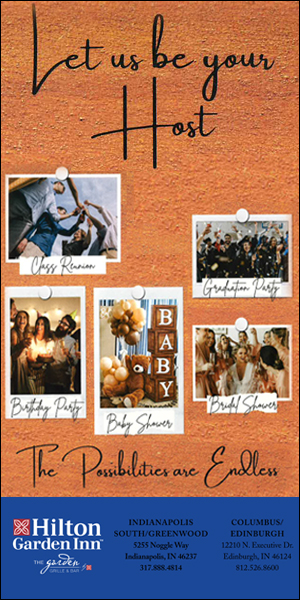
Johnson County family runs Indy gallery for eclectic tastes
By Rebecca Berfanger
After visiting art galleries around Europe and the United States, a Johnson County family decided they wanted to open their own a little closer to home.
“I envisioned an art gallery better than anything we’ve seen in Chicago, New York, Miami, even in Europe,” says Jim Hunter, of Trafalgar. He is the family patriarch as well as the founder of Eye Specialists of Indiana, an optometric referral medical and surgical practice.
In late 2012, after several months of searching, the Hunter family purchased a Greek Revival-style historic building along the Cultural Trail, mere steps from some of Indianapolis’ main attractions, including Monument Circle and Bankers Life Fieldhouse. They decided to give it a shot, not knowing exactly how much work would be required.
And that is how downtown Indianapolis’ Gallery Forty-Two began.
So far, the gamble has paid off for both the gallery and event space with the Hunter family working together in a system that plays up family members’ talents. Sons Curt and Nick Hunter curate the artwork, a mixture of sculpture and paintings in traditional and non-traditional styles. Their parents, Jim and Linda, serve as landlords.
The building the Hunters chose is one of the oldest commercial buildings in Indianapolis. Although earlier research found that the building was built in the 1840s or 1850s, family research indicates it was constructed between 1832
and 1840.
Regardless of the exact construction date, when the Hunters acquired the property five years ago, the now beautifully restored building looked almost nothing like it does today. At the time, it had an extra floor, added sometime before 1870. Sheet metal panels had long covered up the second and third floor of the façade, and concrete blocks filled in the fourth and fifth floor windows since about 2011.
In short: It was an eyesore.
Plus, although there are a few architecture and construction firms that have renovated their share of 80- or even 100-year-old buildings, few structures in central Indiana have survived 150 years or more. As the family worked through the renovations, Jim says, he and Linda did everything contractors for the property would normally do, operating with architects, engineers and subcontractors reporting to them. Jim gives much of the credit to Linda because she would often be at the site while he was at his medical practice.
Because the building is historic, they worked under the guidance of the Indianapolis Historical Preservation Commission and the Department of Metropolitan Development to make the building look as close to the way it looked in the 1860s as possible.
That included replacing bricks in the front with original bricks from the back of the building. The bricks at the back, which are not visible from the street, could be replaced with more modern construction materials.
Adding to the Hunters’ woes was the fact that the building was not structurally safe. “The walls were collapsing toward Washington Street,” Jim says. “From the inside, we had to support the walls and pull them back with rods, and secure the walls with new supports in the ceilings. We had to pull back the entire old brick wall facing Washington Street so that it would be vertical.”
“Because it was built in the 1830s, the foundation was not typical concrete, just stones,” Jim says. “A floor was added to the top of the building that was not there initially. Because of that, 50 percent of the foundation had started to sink. During the renovation, we had to remove a floor, raise up the foundation and re-pour it.”
After years of work, the gallery and event space opened to the public in September 2014.
The interior now consists of simple yet elegant wooden floors and wood trim, plus white walls that do not detract from the artwork. A second-floor balcony overlooks the first floor. The second-floor bar, which dates to the 1800s, was purchased from an antiques dealer in Boston.
The bar often displays artifacts discovered during renovation, including old whiskey and gin bottles possibly hidden from sight during Prohibition, and coffee cups from Thompson’s Dairy Lunch, a popular café for downtown workers, which occupied the building from 1910 to 1940, according to historical articles. A few behind-the-scenes areas offer exposed brick, original terrazzo flooring and a vault door that give a sense of the building’s history.
The third and fourth floors offer storage space, staging areas for catering and additional spaces where bridal parties may prep for weddings.
Katarzyna Kociomyk, a master painter originally from Poland who studied at the Academy of Fine Art in Warsaw, appreciates what the Hunters are doing for art and artists in Indianapolis.
Although she now lives in California, she lived in southern Indiana when she first connected with the gallery. Her husband, a former gallery owner, found Gallery Forty-Two while looking for new representation for Kociomyk. When the gallery owners met with her and her husband, she says, “We connected very quickly. It was one of the most beautiful galleries I’ve ever seen. I had a very nice experience and loved seeing my paintings in the space. I felt very good and respected as an artist working with Nick and Curt.”
Now that the gallery has been open for a couple of years — with only minor changes since its opening in 2014 — Jim says, “I think it’s exactly the way we envisioned it.”
The approximately 30 artists that the gallery represents are a mix of local, national and international talents. All but a handful are still creating art, so they have a direct connection with Gallery Forty-Two for sales, commissioned pieces and occasional meet-the-artist receptions.
The first-floor gallery offers a variety of pieces, including dream-like metal sculptures and paintings by Chicago-based artist Boban Ilic, modern landscapes by New York-based artist H.M. Saffer II, and watercolor landscapes by Indianapolis-based artist Mary Clouse. The gallery also offers bronze sculptures and illustrations by Salvador Dalí.
The second-floor gallery features less traditional artworks, such as Janis Joplin painted in bright, energetic colors by Brazilian artist Bruni Sablan; Mario Andretti painted in the photo-realism style of James Fiorentino; Mark Gray’s portrayals of Indianapolis (and other cities’) sports legends; and Phillip Dutton-White’s race car paintings, which were also featured in a May 2016 show at the gallery to commemorate the 100th running of the Indy 500.
The sports-themed works in this gallery should come as no surprise, considering Curt has experience working in sports marketing. The gallery also offers various styles, he says. “We want to make art more accessible to people. If I don’t understand a piece of art, I might feel like I’m not smart enough. It’s OK to like music or art just because you like it,” Curt says. “I want people to come in and feel comfortable looking at the art, asking questions, to find something they can really connect with.”


